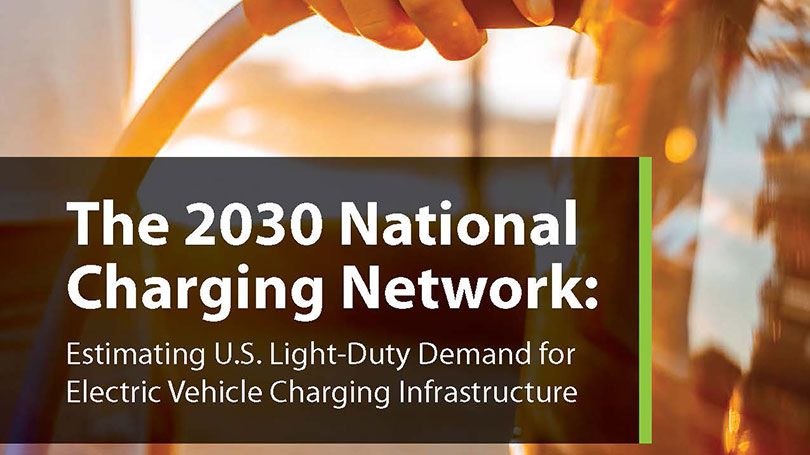New Analysis Guides Development of National Charging Network
June 27, 2023

A new report by the U.S. Department of Energy's National Renewable Energy Laboratory (NREL) will serve as a strategic framework for the development of nationwide electric vehicle (EV) charging infrastructure designed to meet the needs of an anticipated 30–42 million light-duty EVs by 2030.
The framework outlined in the report aligns with transformative goals set by the Biden-Harris administration, the automotive industry, and the United Auto Workers for zero-emission vehicles to comprise the majority of new car sales by 2030. It also coalesces with the Joint Office of Energy and Transportation's (Joint Office's) vision of a convenient, affordable, reliable, and equitable charging network for all Americans.
The report, titled The 2030 National Charging Network: Estimating U.S. Light-Duty Demand for Electric Vehicle Charging Infrastructure, details NREL's quantitative analysis estimating the number, type, and location of chargers needed to power a growing number of light-duty EVs nationwide. It includes a never-before-seen level of detail in a nationwide EV charging infrastructure analysis.
The study is unique in its accounting for region-specific variables, such as weather, travel behavior, housing type, and demographics, as well as types of travel, such as commuting, running errands, ride-hailing, and long-distance road trips—all of which can affect charging demand. The study utilizes the most sophisticated and comprehensive suite of analytical tools available, built on years of studying EV charging and powered by NREL's analytical capabilities.
Local, regional, state, and national infrastructure efforts, including those supported by the Joint Office, can leverage NREL's data-informed findings to build out right-sized charging networks across the nation.
Key report findings:
Convenient and affordable charging at and near home is core to the ecosystem but must be complemented by reliable public fast charging to enable long-distance travel, mobility and ride-hailing services, and charging for those without residential access.
A successful charging ecosystem provides the right balance of charging types and locations. NREL's analysis finds that a national network in 2030 could require approximately 1.2 million publicly accessible charging ports and an additional 26.8 million privately accessible charging ports.
-
1.2 million public charging ports would be comprised of:
-
182,000 publicly accessible fast charging ports—to enable long-distance travel and ride-hailing electrification and to support those who lack access to residential charging
-
1 million Level 2 charging ports at publicly accessible locations—in high-density neighborhoods, office buildings, and retail outlets.
-
-
26.8 million Level 1 and Level 2 charging ports at privately accessible locations—largely homes, multifamily properties, and workplaces.
Continued investments in U.S. charging infrastructure are necessary, though the U.S. is on a path to achieving 2030 goals.
-
Building a convenient, reliable charging network is critically important to make EV charging a seamless experience. Researchers project that the historic infrastructure investments made to date have put the United States on a path to meeting federal clean energy goals, but the pace of investment must be sustained in line with increased demand for EVs.
-
Since President Biden took office in January 2021, EV sales have tripled, and the number of publicly available charging ports has grown by more than 40%. U.S. sales of plug-in EVs have reached about 3.4 million since 2010, and more than 135,000 public chargers currently exist across the country.
-
In addition, recent announcements about a nationwide strategy to encourage domestic EV charging equipment manufacturing indicate that the U.S. EV industry is priming for widespread adoption. These significant federal investments will support needed infrastructure through the growth of the domestic manufacturing base.
The Joint Office and the U.S. Department of Energy's Vehicle Technologies Office supported NREL's multi-faceted analysis, which draws on the laboratory's long-term research expertise and integrated modeling and analysis tools.
To learn more, read the NREL news article.

